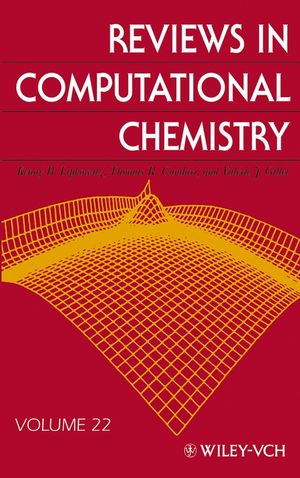Reviews in Computational Chemistry, Volume 22ISBN: 978-0-471-77938-4
Hardcover
392 pages
February 2006
 This is a Print-on-Demand title. It will be printed specifically to fill your order. Please allow an additional 10-15 days delivery time. The book is not returnable.
|
||||||
Introduction.
Classification and Biology.
The Biomolecular Revolution.
Basic Principles of Protein Structure.
Visualization.
Protein Building Blocks.
Protein Structure Hierarchy.
Three Types of Proteins.
Geometry of Globular Proteins.
Protein Domains.
Resources on Protein Structures.
Protein Structure Comparison.
Automatic Identification of Protein Structural Domains.
The Rigid-Body Transformation Problem.
Protein Structure Superposition.
cRMS: An Ambiguous Measure of Similarity.
Differential Geometry and Protein Structure Comparison.
Upcoming Challenges for Protein Structure Comparison.
Protein Structure Classification.
The Structure Classification of Proteins (SCOP).
The CATH Classification.
The DALI Domain Dictionary (DDD).
Comparing SCOP, CATH, and DDD.
Conclusions.
Acknowledgments.
Appendix.
References.
2. Comparative Protein Modeling (Emilio Xavier Esposito, Dror Tobi, and Jeffry D. Madura).
Introduction.
Anatomy of a Comparative Model.
Step 1: Searching for Related Sequences and Structures.
Expert Protein Analysis System (ExPASy).
BLAST and PSI-BLAST.
Protein Data Bank (PDB).
Sequence Alignment and Modeling System with Hidden Markov Models.
Threading.
Threader.
Example: Finding Related Sequences and 3-D Structures.
Step 2: Sequence Alignment.
Preparing the Sequences.
Alignment Basics.
Similarity Matrices.
Clustal.
Tree-Based Consistency Objective Function for Alignment Evaluation (T-Coffee).
Divide-and-Conquer Alignment (DCA).
Example: Aligning Sequences.
Step 3: Selecting Templates and Improving Alignments.
Selecting Templates.
Improving Sequence Alignments With Primary and Secondary Structure Analysis.
Example: Aligning the Target to the Selected Template.
Step 4: Constructing Protein Models.
Satisfaction of Spatial Restraints.
Segment Match Modeling.
Multiple Template Method.
3D-JIGSAW.
Overall Protein Model Construction Methods.
Example: Constructing a Protein Model.
Step 5: Refinement of Protein Models.
Side-Chains with Rotamer Library (SCWRL).
Energy Minimization.
Molecular Dynamics.
Molecular Dynamics with Simulated Annealing.
Step 6: Evaluating Protein Models.
PROCHECK.
Verify3D.
ERRAT.
Protein Structure Analysis (ProSa).
Protein Volume Evaluation (PROVE).
Model Clustering Analysis.
Example: Evaluation of Protein Models.
Conclusions.
References.
3. Simulations of Protein Folding (Joan-Emma Shea, Miriam R. Friedel, and Andrij Baumketner).
Introduction.
Theoretical Framework.
Energy Landscape Theory.
Thermodynamics and Kinetics of Folding: Two-State and Multistate Folders.
Protein Models.
Introduction and General Simulation Techniques.
Coarse-Grained Protein Models.
Fully Atomic Simulations.
Advanced Topics: The Transition State Ensemble for Folding.
Transition State and Two-State Kinetics.
Methods for Identifying the TSE.
Conclusions and Future Directions.
Acknowledgments.
References.
4. The Simulation of Ionic Charge Transport in Biological Ion Channels: An Introduction to Numerical Methods (Marco Saraniti, Shela Aboud, and Robert Eisenberg).
Introduction.
System Components.
Time and Space Scale.
Experiments.
Electrostatics.
Long-Range Interaction.
Short-Range Interaction.
Boundary Conditions.
Particle-Based Simulation.
Implicit Solvent: Brownian Dynamics.
Explicit Solvent: Molecular Dynamics.
Flux-Based Simulation.
Nernst–Planck Equation.
The Poisson–Nernst–Planck (NP) Method.
Hierarchical Simulation Schemes.
Future Directions and Concluding Remarks.
References.
5. Wavelets in Chemistry and Chemoinformatics (C. Matthew Sundling, Nagamani Sukumar, Hongmei Zhang, Mark J. Embrechts, and Curt M. Breneman).
Preface.
Introduction to Wavelets.
Fourier Transform.
Continuous Fourier Transform.
Short-Time Fourier Transformation.
Wavelet Transform.
Continuous Wavelet Transform.
Discrete Wavelet Transform.
Wavelet Packet Transform.
Wavelets vs. Fourier Transforms: A Summary.
Application of Wavelets in Chemistry.
Smoothing and Denoising.
Signal Feature Isolation.
Signal Compression.
Quantum Chemistry.
Classification, Regression, and QSAR/QSPR.
Summary.
References.
Author Index.
Subject Index.



